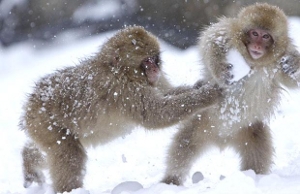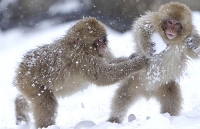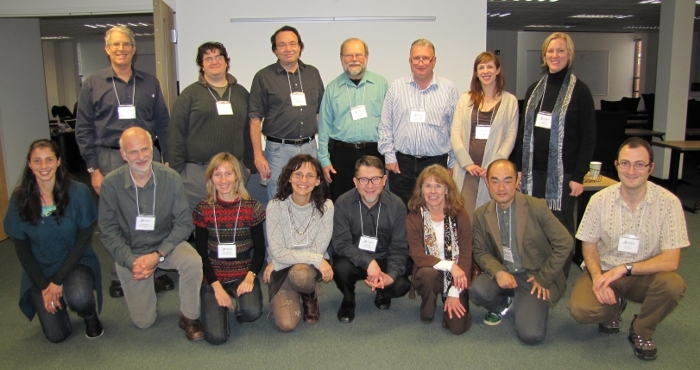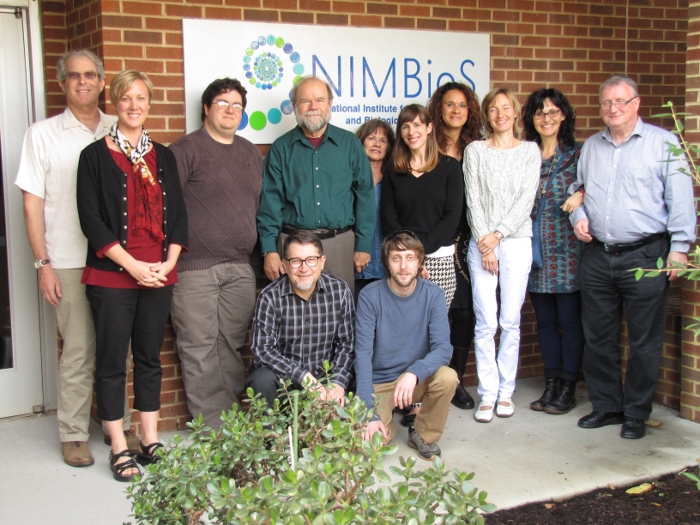| Description | Participants | Summaries | Products |
|---|

Archived NIMBioS Working Group
Play, Evolution, and Sociality
Topic: Play as a window into cognitive evolution and the rules of sociality
Organizers:
Gordon M. Burghardt, Depts. of Psychology and Ecology & Evolutionary Biology, Univ. of Tennessee, Knoxville
Marc Mangel, Dept. of Applied Mathematics and Statistics, Jack Baskin School of Engineering, Univ. of California, Santa Cruz
Elisabetta Palagi, Centro Interdipartimentale Museo di Storia Naturale e del Territorio, Università di Pisa, Pisa, Italy and Unit of Cognitive Primatology and Primate Center, Institute of Cognitive Sciences and Technologies, The National Research Council (CNR), Rome, Italy.
Sergio M. Pellis, Canadian Centre for Behavioural Neuroscience, Dept. of Neuroscience, Univ. of Lethbridge, Lethbridge, Alberta, Canada
Meeting dates: Nov 30-Dec 2, 2011; Oct 29-31, 2012; Oct 30-Nov 1, 2013
Objectives: There are rules and norms underlying social behavior going beyond the "tit-for-tat" games that were the focus of early models simulating social interactions. To cooperate effectively, a forgiving strategy is often needed. How big and how often can transgressions be tolerated before retaliation is warranted? Play, especially social play fighting, provides a window into the dynamics of cognitive and strategic decision-making. Animals compete to gain some advantage (e.g. to bite without being bitten back), but have to do so with restraints (e.g., do not bite too hard) in order for the encounter to remain playful. Such play fighting is found in many lineages of highly social, as well as less social, species. Play can be viewed as having the functions of sharpening social skills during juvenile development and, when continued into adulthood, negotiating complex social relationships. Play fighting thus provides a tool for gaining insight into social behavior more generally, and given the rule structure within which it is bound, is highly accessible to a mathematical approach. This project will develop models for interactions that occur during social play using and comparing game theory, agent-based, and other approaches along with new and advanced comparative models for situating such play in ecological and evolutionary space. Starting from an almost a complete lack of prior models, our goals are to uncover, using mathematical tools, the factors predicting the dynamics, occurrence and trajectory of play in diverse taxa and the ecological, physiological and life history factors that facilitate and maintain it.
Main metrics of success will be publications and presentations showing how the results of mathematical approaches to the dynamics and evolution of play allow the formulation of improved and novel models of social play and application of phylogenetic approaches that foster specific predictions, refined experimental studies, and targeted comparative data to understand, more completely, the organizational dynamics and functions of play in animal behavior. Sustained collaborations are also expected.

Meeting Summaries
| Mtg # | Dates | Agenda | Summary | Photo | Evaluation |
|---|---|---|---|---|---|
| 1 | Nov 30-Dec 2, 2011 | Link | Link | Report | |
| 2 | Oct 29-31, 2012 | Link | |||
| 3 | Oct 30-Nov 1, 2013 | Link |
Meeting 1 Summary. The main goals of this first meeting were to introduce the expertise and backgrounds of the participants in relation to the major issues in play research, in both human and nonhuman animals, amenable to mathematical analysis and modeling. The problems to be dealt with in this project were divided into two major groups: Phylogeny and Play Dynamics. For phylogeny, we did preliminary analyses using a compilation of data on play and traits such as frugivory to examine the process of evolution. We also examined the effect of adult play on diversification and extinction. We will now pursue two strategies for further analyses: 1) pulling in existing databases about play and other traits and running analyses with the initial focus on primates and 2) creating a broader database of play behaviors. The data form to do this was constructed and is now ready for use. In terms of play modeling, there are three subgroups that focus on 1) agent-based model for the evolution of cooperation in which offspring play and learn to be cooperators and parents play a Prisoner's Dilemma game; 2) game theory models of play in relation to learning, cultural evolution, adulthood, and the evolution of behavioral types; and 3) dynamic state variable life history models for understanding the role of play in developing life history skills and the emergence of the 50:50 fairness rule.
Meeting 2 Summary. The second meeting of the working group on play convened with a full complement of play and mathematics experts from around the world. We continued joint discussions and collaborations on three major areas of interest. These included the phylogeny of play and use of state of the art methods of determining the role of ecological and social factors that influence the evolutionary trajectory of play. Besides working on a broad descriptive phylogeny of play across major invertebrate and vertebrate clades, we are focusing on primates, including humans. Our second major thrust is to use various modeling tools to address play evolution. Major interests are in dynamic models, individual based and population models, and game theory models. Our third major interest is in the function and evolution of play signals in well studied groups such as rodents, carnivores, and non-human primates. We ended our meeting with a playful visit to a recreation of Orson Welles' famous War of the Worlds radio broadcast - a classic case of a playful event being taken much too seriously in its initial incarnation.
 |
| Working Group on Play, Evolution, and Sociality, Meeting 1. (Back row, L to R): M. Mangel, B. O'Meara, J. Schank, G. Burghardt, P. Hammerstein, K. Lewis Graham, H. Fouts. (Front row, L to R): S. Dall'Olio, M. Spinka, M. Rehakova, E. Palagi, S. Pellis, B. Smuts, M. Shimada, E. Akçay. Not pictured: M. Bekoff, T. Pellegrini, S. Siviy |
 |
|
Working Group on Play, Evolution, and Sociality, Meeting 3. (Back row, L to R): M. Mangel, H. Fouts, B. O'Meara, G. Burghardt, B. Smuts, K. Lewis Graham, G. Cordoni, M. Rehakova, E. Palagi, P. Hammerstein. (Front row, L to R): S. Pellis, J. Auerbach. Not pictured: J. Schank, E. Akcay
|
NIMBioS Working Groups are chosen to focus on major scientific questions at the interface between biology and mathematics. NIMBioS is particularly interested in questions that integrate diverse fields, require synthesis at multiple scales, and/or make use of or require development of new mathematical/computational approaches. NIMBioS Working Groups are relatively small (up to 10 participants), focus on a well-defined topic, and have well-defined goals and metrics of success. Working Groups will meet up to 3 times over a two-year period, with each meeting lasting up to 2.5 days.
A goal of NIMBioS is to enhance the cadre of researchers capable of interdisciplinary efforts across mathematics and biology. As part of this goal, NIMBioS is committed to promoting diversity in all its activities. Diversity is considered in all its aspects, social and scientific, including gender, ethnicity, scientific field, career stage, geography and type of home institution. Questions regarding diversity issues should be directed to diversity@nimbios.org. You can read more about our Diversity Plan on our NIMBioS Policies web page. The NIMBioS building is fully handicapped accessible.
NIMBioS
1122 Volunteer Blvd., Suite 106
University of Tennessee
Knoxville,
TN 37996-3410
PH: (865) 974-9334
FAX: (865) 974-9461
Contact NIMBioS


